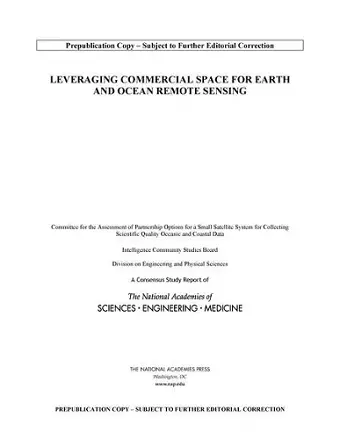Leveraging Commercial Space for Earth and Ocean Remote Sensing
Division on Engineering and Physical Sciences author National Academies of Sciences, Engineering, and Medicine author Intelligence Community Studies Board author Committee for the Assessment of Partnership Options for a Small Satellite System for Collecting Scientific Quality Oceanic and Coastal Data author
Format:Paperback
Publisher:National Academies Press
Published:8th Jul '22
Currently unavailable, and unfortunately no date known when it will be back

Within the past decade an ever-growing number of New Space organizations have emerged that are unencumbered by legacy practices and constraints. By reimagining, creating, and continuously improving SmallSat space technology a new and growing space ecosystem is now in place that is capable of serving a broad stakeholder community of both traditional users and new or nontraditional users.
Current commercial practices are expanding with capabilities including technology and business-driven applications that open the door to a broad and vibrant ecosystem offering a wide range of solutions capable of supporting a growing range of stakeholders. In parallel to traditional approaches, space infrastructure related to manufacturing, such as customized spacecraft buses, instruments, and sensors—including high-resolution imaging and radar systems rivaling the performance of traditional systems—are emerging in both growing volume and with constantly improving capability. On the operational commercial ground stations are now routinely available, as are data management and analytics including cloud computing for data access and archiving. Thus, if properly encouraged and nourished, a broadly capable ecosystem can emerge including new business opportunities for data fusion, analysis, and databuys, as well as ground/space communications that can equally benefit both traditional and nontraditional user communities.
Leveraging Commercial Space for Earth and Ocean Remote Sensing assesses the feasibility and implications of creating and exploiting partnerships for developing, deploying, and operating a system of satellites and supporting infrastructure capable of sensing ocean, coastal, atmospheric, and hydrologic data of sufficient scientific quality to enable prediction models and to support near real time applications of national interest. This report identifies and describes promising options for such a system.
Table of Contents- Front Matter
- Summary
- 1 Introduction
- 2 Current and Future Commercial Landscape
- 3 Hybrid Space Architecture and the Pathway to a New Space Ecosystem
- 4 Science and Applications
- 5 Benefits and Challenges of New Business Models
- 6 Concluding Statement by the Committee
- Appendixes
- Appendix A: the National Oceanographic Partnership Program Challenge of Conducting a Technology Demonstration
- Appendix B: Acronyms and Abbreviations <
ISBN: 9780309286930
Dimensions: unknown
Weight: unknown
94 pages